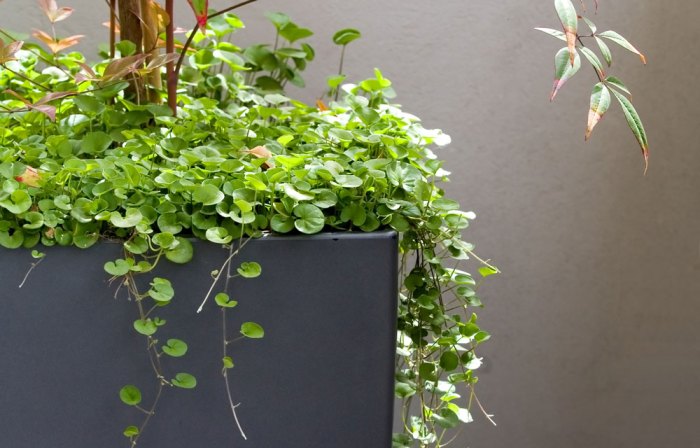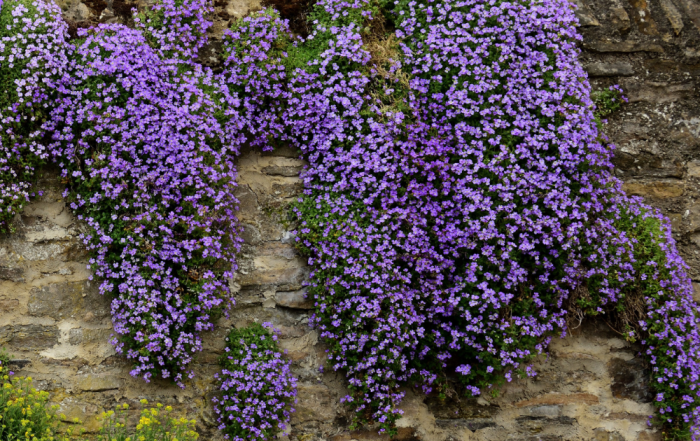Cascading house plant – Cascading houseplants, with their graceful stems and lush foliage, have captivated plant enthusiasts with their undeniable charm. These botanical wonders bring a touch of the outdoors in, creating a vibrant and serene atmosphere within your living spaces.
From the delicate tendrils of the String of Pearls to the cascading foliage of the Spider Plant, the diversity of cascading houseplants offers a wide range of options to suit every taste and decor.
Description and Characteristics
Cascading houseplants, as the name suggests, are characterized by their flowing, vine-like growth habit that gracefully cascades down from a central point, creating a lush, verdant display. These plants typically feature long, trailing stems that bear an abundance of foliage, forming a captivating waterfall effect that adds a touch of elegance and movement to any indoor space.
Cascading houseplants thrive in bright, indirect light and well-draining soil. They prefer moderate temperatures, ranging from 65 to 80 degrees Fahrenheit, and require regular watering to maintain their lush appearance. Fertilizing these plants monthly during the growing season can promote healthy growth and vibrant foliage.
Unique Features
One of the most distinctive features of cascading houseplants is their ability to adapt to various growing conditions. They can be grown in hanging baskets, on shelves, or even on the floor, making them versatile additions to any room. Additionally, these plants are relatively low-maintenance and can tolerate occasional neglect, making them ideal for busy individuals or those new to indoor gardening.
Popular Varieties
Cascading houseplants offer a wide array of options to add a touch of greenery and elegance to your home. From lush trailing vines to cascading foliage, there’s a variety to suit every taste and space.
Here are some of the most popular varieties of cascading houseplants, each with its unique characteristics:
Trailing Vines
Trailing vines are known for their long, flowing stems that can gracefully drape over shelves, windowsills, or hanging baskets.
- Pothos (Epipremnum aureum):Pothos is a classic cascading plant with heart-shaped leaves that come in a variety of colors, including green, yellow, and white.
- Philodendron scandens:Also known as the heartleaf philodendron, this plant features glossy, heart-shaped leaves in a vibrant green color.
- String of Pearls (Senecio rowleyanus):This unique plant has trailing stems adorned with small, round leaves that resemble strings of pearls.
Cascading Foliage
Cascading foliage plants have lush, flowing leaves that create a dramatic waterfall effect.
- Spider Plant (Chlorophytum comosum):Spider plants produce long, arching leaves with variegated white and green stripes.
- Asparagus Fern (Asparagus setaceus):This plant has feathery, cascading foliage that resembles asparagus fern.
- Prayer Plant (Maranta leuconeura):Prayer plants have colorful, variegated leaves that fold up at night, giving the appearance of hands in prayer.
Care and Maintenance

Cascading houseplants, known for their trailing stems and lush foliage, require specific care and maintenance to thrive indoors. Understanding their unique needs is crucial for healthy growth and preventing common problems.
Watering
Cascading houseplants prefer consistently moist soil, but not waterlogged. Allow the top inch of soil to dry out between waterings. Avoid overwatering, as this can lead to root rot and yellowing leaves.
Cascading house plants, with their flowing stems and trailing leaves, create a dramatic vertical accent in any room. For wall planters indoors, these plants offer a space-saving way to bring nature into your home. Explore a wide range of cascading house plants that are perfect for wall planters here , including ivy, ferns, and succulents, and enjoy the lush greenery they bring to your walls.
Fertilizing
Fertilize cascading houseplants monthly during the growing season with a balanced liquid fertilizer. Follow the instructions on the fertilizer label carefully, as over-fertilizing can burn the roots.
Pruning
Regular pruning is essential to maintain the shape and fullness of cascading houseplants. Pinch back the tips of stems to encourage branching and prevent leggy growth. Remove any dead or yellowing leaves promptly.
Cascading house plants are an attractive way to bring greenery into your home. They can be used to add a touch of elegance to any room, and they can also help to improve air quality. If you’re looking for a hanging plant that will help to purify the air in your home, consider one of the best hanging plants for air purification . These plants are known for their ability to remove toxins from the air, and they can help to improve your overall health and well-being.
Cascading house plants are a beautiful and functional way to add some life to your home.
Optimal Growing Conditions, Cascading house plant
To create optimal growing conditions for cascading houseplants, provide bright indirect light, well-draining soil, and adequate humidity. Avoid placing them in direct sunlight, as this can scorch the leaves. Consider using a humidifier or misting the leaves regularly to increase humidity levels.
Design Ideas and Applications: Cascading House Plant

Cascading houseplants bring a touch of nature and elegance to any interior design scheme. Their graceful vines and trailing leaves create a dramatic visual effect that can transform a room.One popular way to use cascading houseplants is to hang them from the ceiling.
This allows their vines to cascade down, creating a lush and inviting atmosphere. Cascading plants can also be placed on high shelves or in macrame hangers, allowing their leaves to trail over the edges.In a living room, a cascading houseplant can add a touch of greenery to a neutral color scheme or complement a more vibrant décor.
In a bedroom, a cascading plant can create a relaxing and serene ambiance. In a kitchen, a cascading plant can add a touch of freshness and vitality.
Cascading house plants, with their long, trailing stems, are a popular choice for hanging baskets and vertical gardens. They create a dramatic and lush effect, adding a touch of nature to any space. If you’re looking for easy-to-care-for hanging plants, consider some of the best easy hanging plants , such as pothos, spider plants, and philodendrons.
These plants are tolerant of a wide range of conditions and require minimal care, making them ideal for busy plant parents. Cascading house plants are a beautiful and versatile way to add greenery to your home, and they’re sure to bring a touch of the outdoors in.
Health Benefits and Air Purification
Cascading houseplants offer a plethora of health benefits, including improving air quality and reducing stress. Research has shown that certain plant species can effectively remove harmful pollutants from the air, creating a healthier indoor environment.
Air Purification
Studies have demonstrated that houseplants can reduce indoor air pollution by absorbing and breaking down harmful gases such as formaldehyde, benzene, and trichloroethylene. These pollutants are commonly found in household products, building materials, and cleaning agents. By removing these toxins, houseplants can improve air quality and reduce the risk of respiratory problems, allergies, and other health issues.
Specific plant species known for their air-purifying abilities include:
- Spider Plant (Chlorophytum comosum)
- Peace Lily (Spathiphyllum wallisii)
- Snake Plant (Sansevieria trifasciata)
- Golden Pothos (Epipremnum aureum)
- Chinese Evergreen (Aglaonema modestum)
Stress Reduction
In addition to improving air quality, cascading houseplants have been shown to reduce stress and promote relaxation. The presence of plants in an indoor environment can create a sense of calm and tranquility. Studies have found that exposure to plants can lower heart rate, blood pressure, and cortisol levels, which are all indicators of stress.
Cascading houseplants, with their graceful and flowing form, can create a soothing and inviting atmosphere. Their lush foliage and delicate flowers can provide a visual escape from daily stressors, helping to reduce anxiety and promote a sense of well-being.
Last Point
Whether you seek to purify the air, reduce stress, or simply add a touch of natural beauty to your home, cascading houseplants are a versatile and rewarding choice. Their unique growth habit and easy maintenance make them ideal for both seasoned plant parents and those just starting their horticultural journey.
FAQ Corner
What are the most popular varieties of cascading houseplants?
Some of the most popular varieties include String of Pearls, Spider Plant, Burro’s Tail, Golden Pothos, and Philodendron scandens.
How do I care for cascading houseplants?
These plants generally prefer bright, indirect light and well-draining soil. Water them thoroughly when the top inch of soil feels dry to the touch.
Do cascading houseplants purify the air?
Yes, many cascading houseplants, such as Spider Plants and Golden Pothos, are known for their air-purifying abilities.